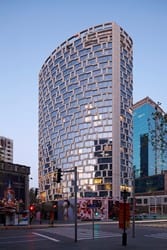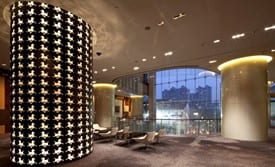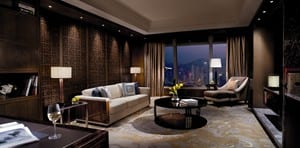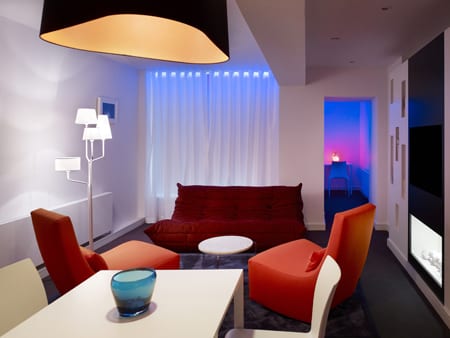 Even by the standards of daringly designed Shanghai hotels, the city’s new Langham Xintiandi ups the genre’s ante. Located in the historic Xintiandi district, the hotel pays homage to the surrounding vernacular while achieving some of the city’s most inventive-and innovative-architectural achievements.
Even by the standards of daringly designed Shanghai hotels, the city’s new Langham Xintiandi ups the genre’s ante. Located in the historic Xintiandi district, the hotel pays homage to the surrounding vernacular while achieving some of the city’s most inventive-and innovative-architectural achievements.
The hotel’s most dramatic element is clearly its façade, clad in stone, used in traditional Xintiandi homes, but realized as a rounded tower with curved edges decorated with an abstract takes on traditional Han dynasty screens. The same motif dominates the hotel’s interiors, as well, a result of the close collaboration between Langham architects New York-based Kohn Pedersen Fox Associates (KPF) and interior designer Peter Remedios, founder of his namesake Long Beach, California-based firm.
 Indeed, the two firms were unusually close, says Remedios. Arriving to the project when it was still just an empty shell, “we took inspiration from and embellished upon the exterior architecture,” Remedios explains. “It’s hard to see where their work ends and ours begins.”
Indeed, the two firms were unusually close, says Remedios. Arriving to the project when it was still just an empty shell, “we took inspiration from and embellished upon the exterior architecture,” Remedios explains. “It’s hard to see where their work ends and ours begins.”
Like KPF, Remedios was clearly inspired by Shanghai’s historic architecture-both the Art Deco period and the courtyard houses of Xintiandi. Bringing this to life meant both sourcing and thinking local while building off a color scheme of black and green hues. Dark local granite was polished and used as flooring and walls in the grand reception area, often accented by glass green details.
 The most important motif, however, is the horse (a key Han symbol) which is elegantly and delicately transformed into a subtle pattern, lasercut into large lobby columns. The horses are accented by an equally authentic paisley motif, which is etched into a series of bronze beams “and look almost like bark on a tree,” says Remedios, “I wanted it to look as if you were walking through a forest.”
The most important motif, however, is the horse (a key Han symbol) which is elegantly and delicately transformed into a subtle pattern, lasercut into large lobby columns. The horses are accented by an equally authentic paisley motif, which is etched into a series of bronze beams “and look almost like bark on a tree,” says Remedios, “I wanted it to look as if you were walking through a forest.”
 Upstairs, the 357 guestrooms are less forest and far more city center-though still with a material palette as rich as in the lobby. Due to the hotel’s unusual façade, there are numerous room shapes and sizes. But all share common design DNA, once again inspired by the Hans, along with the adjoining neighborhood. Walls, for instance, are made from rich leather inlaid with a stitched-on pattern whose geometric shape is reminiscent of the exterior. Rooms also include green and gold wool carpets, which also feature that Han-inspired paisley-like motif.
Upstairs, the 357 guestrooms are less forest and far more city center-though still with a material palette as rich as in the lobby. Due to the hotel’s unusual façade, there are numerous room shapes and sizes. But all share common design DNA, once again inspired by the Hans, along with the adjoining neighborhood. Walls, for instance, are made from rich leather inlaid with a stitched-on pattern whose geometric shape is reminiscent of the exterior. Rooms also include green and gold wool carpets, which also feature that Han-inspired paisley-like motif.
 For Remedios, as much as the building’s exterior propelled his interiors, the Langham’s unique shape also provided some challenges. Oddly, they manifest itself most interestingly in the bathrooms. Along with oversized teak soaking tubs, they also include floor-to-ceiling glass walls, which can create some unusual “modesty” situations. “This was particularly a problem in rooms that directly incorporated the glass from the facade,” Remedios says. “We had to develop subtle screens, or else you had windows directly over the tubs.”
For Remedios, as much as the building’s exterior propelled his interiors, the Langham’s unique shape also provided some challenges. Oddly, they manifest itself most interestingly in the bathrooms. Along with oversized teak soaking tubs, they also include floor-to-ceiling glass walls, which can create some unusual “modesty” situations. “This was particularly a problem in rooms that directly incorporated the glass from the facade,” Remedios says. “We had to develop subtle screens, or else you had windows directly over the tubs.”


